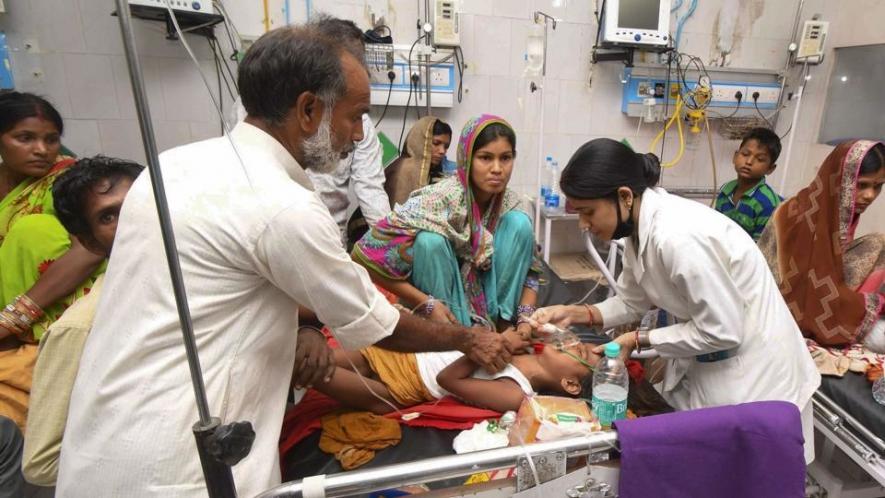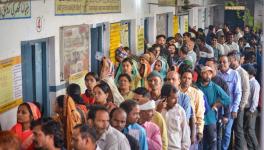Muzaffarpur: Why the Tragedy Was Foretold

In the ongoing tragedy of child deaths in Bihar, some 222 blocks in 12 districts are said to be affected by Acute Encephalitis Syndrome (AES), which mostly affects children of age up to 10 years. Children get very high fever suddenly, with altered consciousness, convulsions may follow, then they slip into coma and die. The epicentre of this outbreak is Muzaffarpur, mainly because it has the only hospital in the region equipped to deal with the disease. Adjoining districts like Vaishali, Sheohar and East Champaran too are affected seriously. But deaths are reported only from two hospitals in Muzaffarpur, where cases are referred to. Many more must be suffering and dying in the hinterland – but nobody is keeping track.
While the mainstream media is obsessing about facilities in the Shri Krishna Medical College & Hospital (SKMCH) in Muzaffarpur and speculating about possible causes of outbreak, two deadly dimensions of this tragedy have escaped notice. One is the preparation and readiness of the public health care system to handle the disease. The other is rehabilitation of survivors.
No Funds – No Preparedness
Have a look at the budgetary allocation (see table below) for handling the disease which is endemic to the region and hence, not a bolt from the blue. It has been surfacing every year for decades. In 2018-19, the state government had proposed a budget of Rs 4,227 crore for the National Health Mission activities in the state. Of this, Rs.3.7 crore – that is, about 0.09% - was meant for AES and Japanese Encephalitis (JE) which is a type of AES caused by a virus. [AES can be caused by other factors too like bacteria, fungi and even low blood sugar.]
However, even the meagre allocation for fighting AES/JE was slashed to one fourth by the central government. Only Rs 85.5 lakh were approved. In fact, the state’s proposal was slashed in toto to Rs 3853 crore. That’s the way the Centre works these days – there is more stress on setting up Health & Wellness Centres, and providing insurance cover under Ayushman Bharat scheme rather than fighting deadly diseases through well-established means.
But this is not all. The approved Budget gives details of how Rs 85.5 lakh were to be spent in dealing with AES/JE. And those details are an eye-opener.
Funds spent on Futile Items
About Rs.66 lakh was allocated for various training programmes. That’s over three fourths of the budget. (See table below)
Training included one state level programme for doctors and “others” costing Rs 15 lakh; one state level meeting for unspecified purposes; and one state and district level training programme for Lymphatic Filariasis officers and drug distributors costing Rs 50 lakh! Apart from both being vector borne communicable diseases, there is no connection between filariasis and AES. Both are, of course, prevalent in the region. This seems to be an accounting sleight of hand. A programme for filariasis is passed under the AES/JE head, by both the state and central government mandarins!
Besides this, Rs 19 lakh were spent on printing of revised version of the Standard Operating Procedure (SOP) for AES/JE.
The only really useful expenditure in this short list is fogging operations using Technical Malathion – a toxin used to kill mosquitoes. JE is transmitted by Culex mosquitoes. But the amount is only Rs.50,000! For 12 endemic districts! Just the district of Muzaffarpur has over 50 lakh population spread over more than 8,000 villages. How Rs 50,000 will suffice for this is anybody’s guess.
So – the battle against AES was lost before it was started. But there is more.
Crumbling Lower Level Healthcare System
Muzaffarpur has 154 sub centres, 29 Primary Health Centres, nine Community Health Centres and one District Hospital, according to the Rural Health Statistics for 2018, put out by the Ministry of Health. For nearly half a crore people, this represents a fraction of the need. In most of these centres, doctors and paramedical staff are short of the required standards. Transport vehicles are rare, as parents of most AES patients have been finding out in the ongoing outbreak because they had to rush the ailing child to Muzaffarpur, spending thousands of rupees on private transport. Experts say that a quick infusion of dextrose through an intra-venous drip can resuscitate the failing body of the child if AES has been caused by low blood sugar levels. If these arrangements were there in sub centres and PHCs, there would be no need to hurry to Muzaffarpur – and no need to die.
While the Union health minister, and the Bihar government have been rightly castigated for failing to expand the sole referral hospital (SKMCH) as promised repeatedly, not much attention has been given to their criminal negligence of the primary healthcare delivery system.
Malnutrition and Summer Vacations
Muzaffarpur has some of the worst child health and nutrition indicators. According to district level data of the last National Family & Health Survey (NFHS 4) carried out in 2015-16, just about 8% of all infants (below two years of age) were receiving adequate diet, about 49% of children under five years of age were stunted and 42% were under-weight. A staggering 59% of children below five years were anaemic, while 53% of women and 33% men below 50 years were anaemic.
These children have a lifeline of sorts – the mid-day meal scheme under which food is provided in schools. According to Education Ministry’s data on midday meal scheme implementation in Muzaffarpur, some 3.1 lakh (out of 5.14 lakh) children enrolled in primary sections and 1.6 lakh (out of 2.99 lakh) in upper primary sections were getting midday meals.
But the summer vacations are on at present. That means no food for all these kids. Add to that the intense heat wave conditions in the region and the ground is set for diseases to strike down these children. The authorities – had they any concord with the people – should have known all this.
They were indifferent, the funds were lacking, the political will was tepid – and the focus of all those that matter is more on making government schemes like Ayushman Bharat succeed. The children who have died were doomed by this indifference.
Those who survive
The most neglected part of the AES outbreak is that many children survive the disease – but are left with severe mental effects. This requires extensive rehabilitation and care and most will be left with life long damage. It is shocking that no attention has been paid by successive governments to this aspect. The affected children and their parents are left to fend for themselves. In fact, in the state’s proposal for funding, there is an item called “Rehabilitation Setup for selected endemic districts” for AES/JE, but the fund requirement is stated as zero! The central government too did not change this and rubber stamped it as zero.
What this brief glimpse of the AES tragedy in Bihar shows is that public heath systems are being destroyed both by under-funding and by complete inability to understand the lives and needs of the people. This points to a dark future where more and more diseases will ravage people but only those who can pay will survive.
Get the latest reports & analysis with people's perspective on Protests, movements & deep analytical videos, discussions of the current affairs in your Telegram app. Subscribe to NewsClick's Telegram channel & get Real-Time updates on stories, as they get published on our website.
























